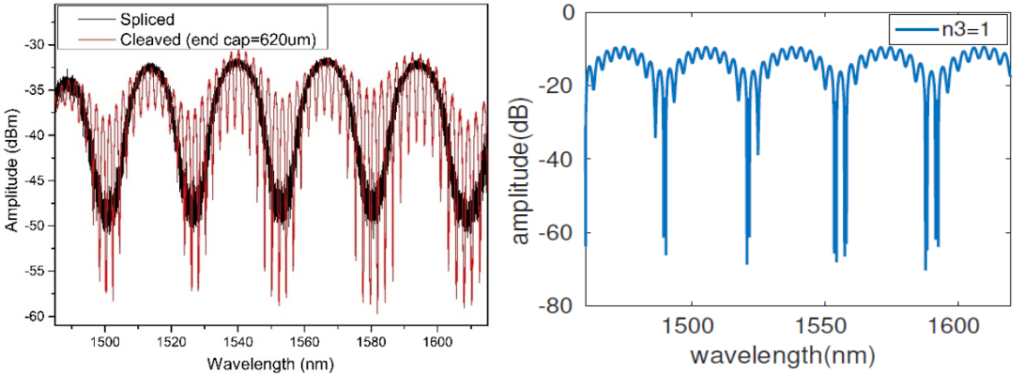Task 4.2: Development and evaluation of fibre-optic based sensor for localized temperature monitoring
The FP cavity was fabricated by using the fsL to micro-machine a micro-hole at the end face of a single mode fibre, followed by fusion splicing, thereafter, forming the cavity. After the splice, the sample was cleaved close to the cavity. In the Fig.4.1 we show two samples of this design. On the left (a) we present a Fabry Perot with cavity size of ~40μm and end cap of ~620μm and (b) cavity size of ~65μm and end cap of ~245μm.

We show in Fig 4.2 the measured FP spectrum with cavity size of ~40μm and end cap of ~620μm vs the simulated spectrum with the same characteristics. Similarly, we show Fig 4.3 the measured FP spectrum with cavity size of ~65μm and end cap of ~245μm vs the simulated spectrum. The latter was chosen to integrate a fibre Bragg grating inside (FBG) as close as the cavity as possible, its spectrum is shown in Fig.4.4; the integration of the FBG affects the resonances, but measurements are not greatly affected. We proceeded to the characterization to temperature and surrounding refractive index sensitivity.



For temperature characterization the sample were placed in a climate chamber or Qpod where the temperature was controlled with an accuracy of 0.1 °C with incremental steps of 5°C from 20 – 50 °C. For refractive index the sample were immersed in a salted water mixture whose refractive index was slightly modified by adding small quantities of water. The refractive index of solution was measured with a handheld Abbe refractometer accurate to 10-4 RIU. The applied demodulation technique was based on the computation of the wavelength shift of the most sensitive resonance in our observable spectrum.



Fig. 4.5: Sensor response to (L) temperature, (C) wavelength vs refractive index, (R) amplitude vs refractive index.
The FBG showed a standard response of 9.86 pm/°C and no response when the surrounding refractive index changes. The FP cavity exhibited a similar response of 9.22 pm/°C and a refractive index sensitivity of 4.26 nm/RIU and -34.7dB/RIU, for wavelength and amplitude, respectively. The FP cavity sensitivity requires improvement by experimenting with cavity designs and materials.
To increase the sensor sensitivity, it was critical to access the central cavity, Fig. 4.6.


Fig 4.6: The cavity design, with access via the micro-holes
In Fig. 4.7 we observe typical refractive index (RI) measurements from 1.34 to 1.375 (aqueous index regime), with sensitivity of ~1000nm/RIU, and linearity of 99.7%. The FP temperature sensitivity was measured as 9.22pm/°C at 1550nm. Given that we have a refractive index sensitivity of ~1000nm/RIU, the temperature cross sensitivity of the FP cavity is given only as ~9.2 x 10-6 RIU/°C.

Our research efforts were to make the cavity sensitive to oxygen, directly filling the cavity with an appropriate oxygen sensitive material, haemoglobin. Haemoglobin responds to pH, temperature, CO2 and O2 concentrations and we were careful to eliminate all but the presence of oxygen. The haemoglobin was made into a 5mg/ml solution in phosphate buffer solution (PBS), into which the fibre was immersed for 24 hours, with the haemoglobin deposited in the cavity via passive adherence. The experiments were carried out in PBS solutions in stabilised, deionised water, and sodium bicarbonate ensured the haemoglobin was converted to oxyhaemoglobin, as any dissolved CO2 was converted to carbonate groups. This change modified the refractive index of the cavity and walls and we anticipated a shift in the recovered wavelength. We used an Ocean Insight NeoFox sensor to ensure that we were observing only oxygen-related changes throughout our experiments of the oxygen sensor. In Fig. 4.8, we observe the wavelength shift spectrum of the first dip in PBS and PBS with sodium bicarbonate.

The same sensor was purified with ethanol and repositioned in haemoglobin for 24 hours; it was placed in a PBS solution together with the commercial oxygen sensor (NeoFox) and with a constant flow of nitrogen gas, oxygen was gradually removed from the PBS solution.

